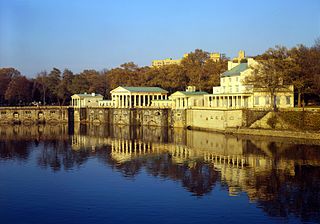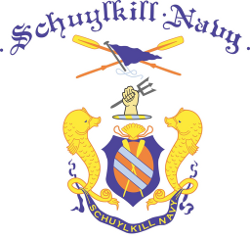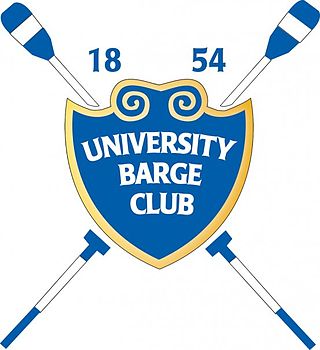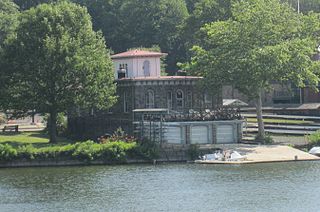
Rowing, sometimes called crew in the United States, is the sport of racing boats using oars. It differs from paddling sports in that rowing oars are attached to the boat using oarlocks, while paddles are not connected to the boat. Rowing is divided into two disciplines: sculling and sweep rowing. In sculling, each rower holds two oars—one in each hand, while in sweep rowing each rower holds one oar with both hands. There are several boat classes in which athletes may compete, ranging from single sculls, occupied by one person, to shells with eight rowers and a coxswain, called eights. There are a wide variety of course types and formats of racing, but most elite and championship level racing is conducted on calm water courses 2 kilometres (1.2 mi) long with several lanes marked using buoys.

Boathouse Row is an historic site which is located in Philadelphia, Pennsylvania, on the east bank of the Schuylkill River just north of the Fairmount Water Works and the Philadelphia Museum of Art. It consists of a row of fifteen boathouses housing social and rowing clubs and their racing shells. Each of the boathouses has its own history, and all have addresses on both Boathouse Row and Kelly Drive.

The Fairmount Water Works in Philadelphia, Pennsylvania, was Philadelphia's second municipal waterworks. Designed in 1812 by Frederick Graff and built between 1812 and 1872, it operated until 1909, winning praise for its design and becoming a popular tourist attraction. It now houses a restaurant and an interpretive center that explains the waterworks' purpose and local watershed history. It was designated a National Historic Landmark in 1976 for its architecture and its engineering innovations. It was the nation's first water supply to use paddle wheels to move water.

The Schuylkill Navy is an association of amateur rowing clubs of Philadelphia. Founded in 1858, it is the oldest amateur athletic governing body in the United States. The member clubs are all on the Schuylkill River where it flows through Fairmount Park in Philadelphia, mostly on the historic Boathouse Row.

The Lighthouse on Turtle Rock is a lighthouse built in 1887 to aid traffic on the Schuylkill River near Philadelphia, Pennsylvania. The lighthouse was constructed by Frank Thurwanger at a cost of $2,663 on an area of land just west of Boathouse Row. The lighthouse has a hexagonal lantern room with an octagonal walkway. Gas was first used to power the light, but in 1990, when the lighthouse was repainted and received a new wooden balustrade and newel posts, the beacon was electrified.

Bachelors Barge Club is an amateur rowing club located at #6 Boathouse Row in the historic Boathouse Row of Philadelphia, Pennsylvania. It is the oldest continuously operating boathouse in the United States. It went through renovations as part of the "Light Boathouse Row" initiative, in which new LED lights were fitted to each of the boathouses. Bachelors Barge Club is currently home to several programs, including the Conestoga High School Crew Team, and the Drexel University Crew Team, among several others.

Max Schmitt in a Single Scull is an 1871 oil-on-canvas painting by the American artist Thomas Eakins, Goodrich catalogue #44. It is in the permanent collection of the Metropolitan Museum of Art. Set on the Schuylkill River in Philadelphia, Pennsylvania, it celebrates Eakins's friend Max Schmitt's victory in the October 5, 1870, single sculls competition.

Seán Joseph Drea is a former Olympic rower from Ireland, specialising in the single scull. He won the Henley Royal Regatta's Diamond Sculls three years in a row, and was the first Irish rower to win a World Championship medal securing silver in the 1975 World Championships.

University Barge Club of Philadelphia is an amateur rowing club located at #7 in the historic Boathouse Row of Philadelphia, Pennsylvania. It is listed on the National Register of Historic Places and designated a National Historic Landmark. The club's founding, in 1854, is considered the "dawn of organized athletics in the University of Pennsylvania." Known as "the upper-class rowing club," UBC is a founder, and the most senior member, of the oldest amateur athletic governing body in the United States, the Schuylkill Navy.

Pennsylvania Barge Club is an amateur rowing club, situated along the historic Boathouse Row of Philadelphia, Pennsylvania. It was founded in 1861 and joined the Schuylkill Navy in 1865. The club's boathouse, at #4 Boathouse Row, is also known as the Hollenback House, named for William M. Hollenback, Jr., who served as President of USRowing from 1979 until 1985.

Crescent Boat Club is an American amateur rowing club located at #5 Boathouse Row in the historic Boathouse Row of Philadelphia, Pennsylvania. It was founded in 1867 when Pickwick Barge Club and Iona Barge Club merged. Crescent Boat Club joined the Schuylkill Navy in 1868. In 1871, Crescent competed in and won the doubles event in the first regatta of the National Association of Amateur Oarsmen, an event "which undoubtedly helped the sport greatly."

Penn Athletic Club Rowing Association is an amateur rowing club located at #12 Boathouse Row in the historic Boathouse Row of Philadelphia, Pennsylvania. Penn AC was founded in 1871 as the West Philadelphia Boat Club. Penn AC has been a destination for elite rowers looking to make the US National Team, ever since John B. Kelly Sr. joined Penn AC after a schism with his former club, Vesper.
The Vesper Boat Club is an amateur rowing club located at #10 Boathouse Row in the historic Boathouse Row of Philadelphia, Pennsylvania. Founded in 1865 as the Washington Barge Club, the club's name was changed to Vesper Boat Club in 1870.

Malta Boat Club is an amateur rowing club located at #9 Boathouse Row in the historic Boathouse Row of Philadelphia, Pennsylvania. In 1865, the Club joined the Schuylkill Navy when it relocated to the Schuylkill River from the Delaware River and purchased the facilities of the now defunct Excelsior Club. While on the Delaware, the club occupied a house on Smith’s Island where the club stored its boat called the "Minnehaha". The club was founded by members of the Minnehaha Lodge of the Sons of Malta. The Sons of Malta, originally organized in the South, did not survive the Civil War.

Undine Barge Club is an amateur rowing club located at #13 Boathouse Row in the historic Boathouse Row along the Schuylkill River in Philadelphia, Pennsylvania. The club was founded in 1856. Undine was not initially listed as a founder of the Schuylkill Navy, but is now considered a founder because an Undine member, Mr. B. F. Van dyke, was elected to represent the club as secretary treasurer of the Navy from its birth in 1858. In 1860, Undine purchased Keystone Barge Club's boat and equipment, as Keystone had disposed of its boathouse.

Philadelphia Girls' Rowing Club is an amateur rowing club located at #14 Boathouse Row in the historic Boathouse Row along the Schuylkill River in Philadelphia, Pennsylvania. It is the oldest all-female rowing club in existence. Built in 1860, the club's boathouse is the oldest structure on Boathouse Row, which is listed on the National Register of Historic Places and designated a National Historic Landmark.

The College Boat Club of the University of Pennsylvania is the rowing program for University of Pennsylvania Rowing, which is located in the Burk-Bergman Boathouse at #11 Boathouse Row on the historic Boathouse Row of Philadelphia, Pennsylvania. Its membership consists entirely of past and present rowers of the University of Pennsylvania.
Gillin Boat Club is the rowing program for St. Joseph's University Rowing and St. Joseph's Prep Rowing. It is situated at the 1,000-meter mark of the Schuylkill River race course in Fairmount Park, Philadelphia, Pennsylvania. Gillin Boat Club was admitted to the Schuylkill Navy in 2004, by a unanimous vote of the Navy's members.

The Union Boat Club, founded in 1851, is an athletic club in Boston. It is the longest continuously operating rowing club in Boston. Located in the Beacon Hill neighborhood along the Charles River, the Club has grown beyond rowing and now features squash and general fitness facilities for its 700 members. In 1914, UBC placed second in the prestigious Grand Challenge Cup. The 1914 crew lost to Harvard after beating a crew from Germany to enter the finals at the Henley Royal Regatta.

The Thomas Eakins Head of the Schuylkill Regatta is a rowing race held annually during the last weekend in October on the Schuylkill River in Philadelphia, Pennsylvania. The HOSR is the final race in the Fall Fury series, which includes the Head of the Ohio and the Head of the Connecticut. Along with the Head of the Charles and the Head of the Connecticut, the HOSR is considered one of the three “fall classics.” The HOSR is one of the marquee races in the Philadelphia Classic Regatta Series, which also includes the Stotesbury Cup Regatta, the Philadelphia Scholastic Rowing Championship, the Schuylkill Navy Regatta, and the Independence Day Regatta.
Regattas such as the Head of the Charles in Boston and the Head of the Schuylkill in Philadelphia are to the rowing world what the New York Marathon and the Boston Marathon are to running.























